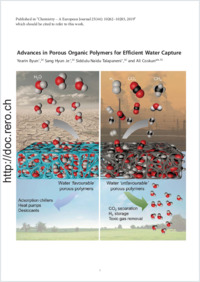Advances in porous organic polymers for efficient water capture
- Byun, Yearin Graduate School of EEWS, Korea Advanced Institute of Science and Technology (KAIST), Republic of Korea
- Je, Sang Hyun Graduate School of EEWS, Korea Advanced Institute of Science and Technology (KAIST), Republic of Korea
- Talapaneni, Siddulu Naidu Graduate School of EEWS, Korea Advanced Institute of Science and Technology (KAIST), Republic of Korea
- Coskun, Ali Graduate School of EEWS, Korea Advanced Institute of Science and Technology (KAIST), Republic of Korea - Department of Chemistry, University of Fribourg, Switzerland
-
2019
Published in:
- Chemistry – A European Journal. - 2019, vol. 25, no. 44, p. 10262–10283
English
Desiccant driven dehumidification for maintaining the proper humidity levels and atmospheric water capture with minimum energy penalty are important aspects in heat pumps, refrigeration, gas and liquid purifications, gas sensing, and clean water production for improved human health and comfort. Water adsorption by using nanoporous materials has emerged as a viable alternative to energy‐intensive industrial processes, thus understanding the significance of their porosity, high surface areas, vast pore volumes, chemical and structural features relative to the water adsorption is quite important. In this review article, important features of nanoporous materials are presented, including zeolites, porous carbons, as well as crystalline and amorphous porous organic polymers (POPs) to define the interactions between the water molecules and the polar/non‐polar functional groups on the surface of these nanoporous materials. In particular, focus is placed on the recent developments in POPs in the context of water capture as a result of their remarkable stability towards water and wide range of available synthetic routes and building blocks for their synthesis. We also highlighted recent approaches to increase the water sorption capacity of POPs by modifying their structure, morphology, porosity, and chemical functionality while emphasizing their promising future in this emerging area.
- Faculty
- Faculté des sciences et de médecine
- Department
- Département de Chimie
- Language
-
- English
- Classification
- Chemistry
- License
-
License undefined
- Identifiers
-
- RERO DOC 327394
- DOI 10.1002/chem.201900940
- Persistent URL
- https://folia.unifr.ch/unifr/documents/307963
Statistics
Document views: 212
File downloads:
- pdf: 450
